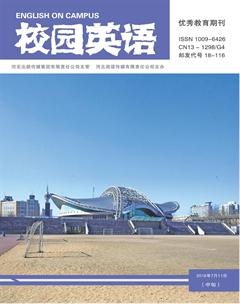A Prototype—Theoretical Approach to Domestication and Foreignization
蔺一方
【Abstract】Since the 1980s, Prototype Theory has been introduced into translation studies by some translation scholars. This paper discusses the translation of Moment in Peking with the help of Prototype Theory.
【Key words】Prototype Theory; Domestication and foreignization; Best exemplar
Moment in Peking is written in English by Lin Yutang which catches many peoples attention no matter in China or aboard. Since this novel published, it is back-translation into Chinese by many translators included Zhang Zhenyu and Yu Fei. Zhang and Yu both adopted strategies of foreignization and domestication during their translating process. Domestication puts an emphasis on the indigenous language to carry out the translating activities, and foreignization remains the source texts cultures and backgrounds. Translation is an activity of reconstructing the best exemplar of the source language through the exemplars of the target language, with prototypes as the ultimate reference. The best exemplar of the source language should be equivalent to the best exemplar of the target language to the largest degree.
Example 1: Lin: A baby emperor, three years old
Zhang Zhenyus Version: 宣统三岁登基
Yus Version: 年方三岁的冲龄皇帝
“Emperor” is the title of paramount leader in Imperial China. In this sentence, “a baby emperor” refers to last emperor in Chinese history. He was supported to be the puppet Emperor in Anti-Japanese War whose reign-title was Xuantong (宣统). According to this cultural background, Zhang translates “a baby emperor” into “宣统” rather than “小皇帝” as the statement of the original text. Zhang adopts the strategy of domestication to translate this phrase. With the help of Chinese background, readers can have a better understanding of this sentence. While, Yu translates “a baby emperor” into “冲龄皇帝”. “冲龄” means the enthronement of emperor in his childhood. He adopts the translation strategy of foreignization. By adopting this strategy, he makes his version faithful to the original version. Recently, few of Chinese know the exact meaning of “冲龄”, so “宣统” is a better version of a baby emperor. Therefore, Zhangs version can be taken as the best exemplar of the prototype.
Example 2: Lin: I would like to be the little ferryman in The Three Kingdoms
Zhangs Version: 我愿给他做个渡船夫
Yus Version: 我愿意做《三国演义》里那个艄公
Chuko Liang is a brilliant politician and militarist in the Three Kingdom Period. In Chinese eyes, he is the representative figure of loyal minister and wise man. In this cultural context, Atung compared Chiang to Chuko Liang while himself to the ferryman in order to show his respect and submission to Chiang. However, Zhang does not translate this information of The Three Kingdoms but omits it. As for this sentence, he uses the strategy of domestication. Yu adopts the strategy of foreignization to make this sentence faithful to the original context. And Yus version contains the necessary information of this sentence. He translates Chuko Liang, the classical character and The Three Kingdoms, Chinese famous masterpiece faithfully without any omission in order to make his expression be most close to the original text. Nevertheless, different from Yu, Zhang omits the important information of the original text. But not every Chinese reader is familiar with the information of The Three Kingdoms, so Yus version is better and approaching to the prototype.
Both Zhang Zhenyus version Jinghua Yanyun and Yu Feis version Shunxi Jinghua are significant in the area of Chinese translation. Nevertheless, there are also some differences between Zhangs version and Yus version in choice of translation strategies to translate cultural-related words and phrases. Zhang mostly uses the strategy of foreignization which makes his version convey the accurate message of the source text. Yu uses strategy of domestication much more which can eliminate the strangeness and foreignness of the source text. People cannot distinguish which strategy is much better because they are complementary to each other. Both domestication and foreignization can help the translator to find the best exemplar during translation process.
References:
[1]Lin Yutang.Moment in Peking[M].Beijing:Foreign Language Teaching and Research Press,1999.
[2]林语堂.郁飞译.瞬息京华[M].长沙:湖南文艺出版社,1999.
[3]林语堂.张振玉译.京华烟云[M].西安:陕西师范大学出版社,2005.

